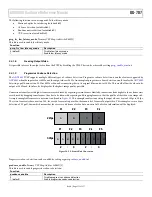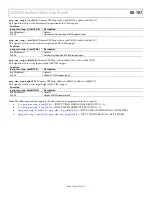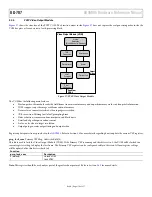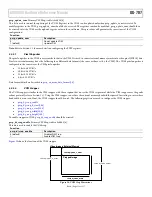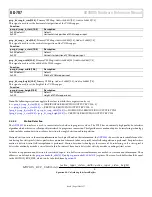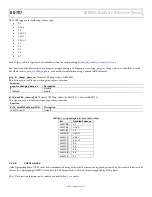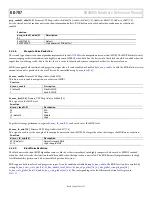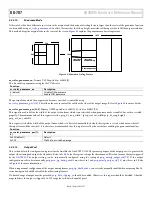
ADV8005 Hardware Reference Manual
UG-707
pvsp_motionbuf0_addr[31:0]
, Primary VSP Map,
Address 0xE818[7:0]; Address 0xE819[7:0]; Address 0xE81A[7:0]; Address 0xE81B[7:0]
This signal is used to set the start address of motion information buffer 0. Motion buffers are needed only when motion adaptive
deinterlacing is enabled for interlaced input.
Function
pvsp_motionbuf0_addr[31:0]
Description
0x00000000 (default)
Default
0xXXXXXXXX
Start address of motion buffer 0
pvsp_motionbuf1_addr[31:0]
, Primary VSP Map,
Address 0xE81C[7:0]; Address 0xE81D[7:0]; Address 0xE81E[7:0]; Address 0xE81F[7:0]
This signal is used to set the start address of motion information buffer 1. Motion buffers are needed only when motion adaptive
deinterlacing is enabled for interlaced input.
Function
pvsp_motionbuf1_addr[31:0]
Description
0x0007E900 (default)
Default
0xXXXXXXXX
Start address of motion buffer 1
3.2.3.4.
Low Angle De-interlacing
The ultra low angle de-interlacing interpolation algorithm (ULAI) developed by ADI performs intra field interpolation for the de-interlacing
function. It is capable of determining the correct direction by examining several different directions and interpolating missing pixels based on
this information. This results in higher quality low angle interpolation and reduces the effect of jaggies.
The ultra low angle interpolation function is only used for converting from interlaced to progressive formats. It can be enabled or disabled by
asserting or de-asserting register
di_ulai_enable
, Primary VSP Map,
Address 0xE84C[3]
This bit is used to enable the ultra low angle de-interlacing algorithm (ULAI).
Function
di_ulai_enable
Description
0
Disable ULAI
1 (default)
Enable ULAI
3.2.3.5.
Cadence Detection
cadence detection can handle multiple different types of cadences, typically introduced when content originated as film format
but was converted into interlaced format for broadcast. Examples of such conversion can be seen in
. The PVSP is able to detect arbitrary
cadences and even unknown cadence modes, with per pixel correction for combing artifacts.
There are several features of cadence detection, including the reliable detection of 2:2 cadences for PAL video and the detection of poor editing
techniques often found in films converted to video standards (this may introduce artifacts). These artifacts are caused by multiple cadences in
the same source as well as fast switching from film to video or between different cadences.
For an interlaced video input, cadence detection can be enabled or disabled by asserting or de-asserting
. For progressive
video input, cadence detection can be enabled or disabled by asserting or de-asserting
di_cadence_enable
, Primary VSP Map,
Address 0xE84C[2]
This bit is used to enable cadence detection.
Function
di_cadence_enable
Description
0
Disable cadence detection
1 (default)
Enable cadence detection
Rev. A | Page 121 of 317







